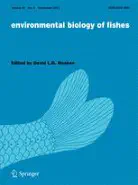Population structure, production and feeding habit of the sand goby Pomatoschistus minutus (Actinopterygii: Gobiidae) in the Minho estuary (NW Iberian Peninsula)

Abstract
Estuaries are highly productive and heterogeneous ecosystems, and hence they provide an excellent opportunity to study the population structure and feeding patterns of euryhaline species like the sand goby Pomatoschistus minutus. In this context the population dynamics of the sand goby was investigated during 18 months in the Minho estuary (NW Iberian Peninsula). The fish density varied significantly among estuarine areas and seasons, with most of the individuals being caught near the river mouth during the autumn (38 % of the total). Males, females and juveniles were not spatially segregated, as well as fishes belonging to different size classes. The sand goby fed mostly on crustaceans (Frequency of Occurrence - FO) = 35 %; Relative Abundance - RA = 40 %), detritus (FO = 27 %; RA = 23 %) and annelids (FO = 15 %; RA = 14 %), with no obvious difference between the diet of males and females. The density (up to 20 times) and the secondary production (up to 16 times) of the sand goby were substantially higher than in other southern European estuaries. Our results highlighted that the population dynamics of the sand goby can vary considerably among nearby systems and that the Minho estuary, probably due to the lower temperature and salinity values and also the different water circulation regime found in this system when compared to other Iberian estuaries, promotes noticeable differences on the P. minutus population dynamics.